Like many scientists, Research Assistant Professor Zachary Sims wants to change the world.
Unlike many scientists, he hopes you don’t notice.
“Alloy and material innovations often go unrecognized because people don’t have to know they are using them to benefit from them,” he said. “New alloy discoveries have driven many day-to-day quality of life improvements for centuries. In recent decades, they have enabled more efficient energy production, high-speed planes, safer automobiles, and many other advances we take for granted in modern life.”
A Vol through and through, Sims earned his bachelor’s degree from UT in 2014, then stayed on to complete his PhD in energy science and engineering in 2020. After two years working at Lawrence Livermore National Laboratory (LLNL) in California, he has returned as a member of Rocky Top’s faculty.
“It’s surreal,” Sims said. “I am a child of Tennessee, and it has always been home to me, but I thought my road back here would be much longer. I could not be happier to be back at my alma mater.”
As a member of the University of Tennessee Oak Ridge Innovation Institute, Sims holds joint positions at Oak Ridge National Laboratory and UT. Among all the engineering departments at UT, he had no doubts that MSE was the place for him.
“During both my graduate career and my time at LLNL, I collaborated closely with many MSE faculty,” he said. “They were deeply knowledgeable and rigorously applied world-class scientific principles to achieve a deeper understanding of material behavior and performance. Now that I have been welcomed among those faculty, it feels like I am part of something bigger.”
Sims has always admired UT’s mission to create positive economic, social, and environmental impacts in both the local and global community. He integrates that philosophy into his own work.
As a doctoral student, Sims performed foundational research on a new alloy that could improve automobile engine efficiency—and, in addition to the alloy’s mechanical and structural properties, Sims carefully considered how broad use of the new material might impact existing supply chains.
Now, Sims’ principal research goal is to improve the sustainability of cutting-edge materials and their industrial production practices. One of his current focus areas is reducing the use of critical elements like cobalt in high-performance alloys.
“Cobalt is important to numerous energy generation and national security applications, but it has high supply volatility and poor ethical standards in its extraction,” Sims said. “Finding reduced-cobalt or cobalt-free alloys for those applications would stabilize the cobalt supply, lower costs, and make it possible to reshore production to the US.”
He is excited to explore this possibility with the experts and cutting-edge facilities UT has to offer.
“UT is well poised to be a leader for material and manufacturing innovations and workforce development,” he said. “In addition to the bleeding-edge technology available here, the healthy environment of collaboration among faculty members and industrial partners creates an atmosphere of scientific growth and teamwork that is hard to find at other institutions.”
Sims is eager to share that collaborative enthusiasm with new Vols, encouraging them to explore cross-disciplinary partnerships with industry representatives and other academics. In addition, he is committed to helping his students consider the far-reaching impacts of their work so they can pursue both successful and influential careers after graduation.
He also hopes to pass on the scientific flexibility he learned here.
“Adaptability is the most valuable skill any scientist can have,” he said. “Problems and their solutions will change throughout our careers, and we have to change our approach with them. UT helped to create in me a willingness to see the areas ripe for scientific discovery, then adapt my skill set and thought processes to meet those needs.”
As he settles back in his home sweet home, Sims is looking forward to shaping new engineers and new alloys—and seeing the results of his labor slide invisibly into the daily routines of the people around him.
“I hope I can make innovations that quietly change the lives of millions of people around the world for the better,” he said.
Contact
Izzie Gall (865-974-7203, egall4@utk.edu)
